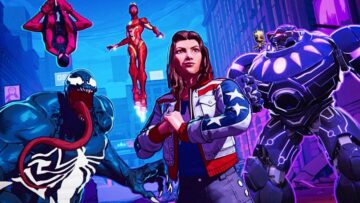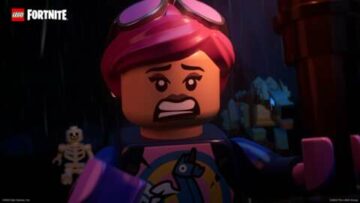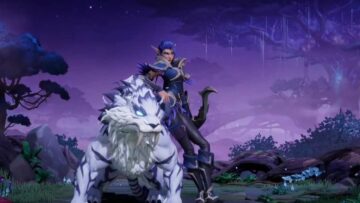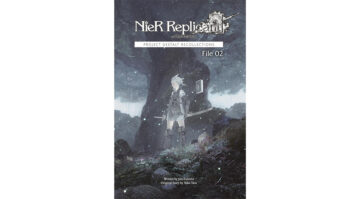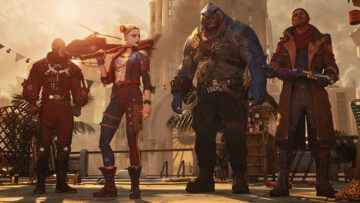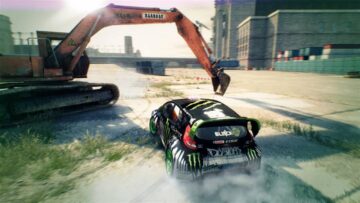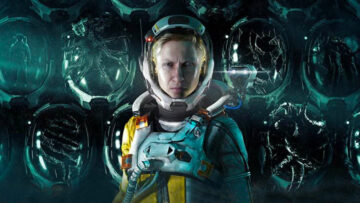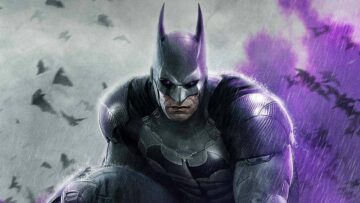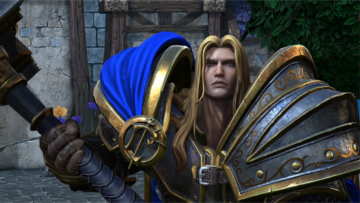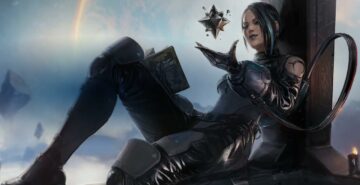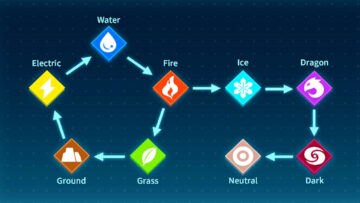Alan Wake 2 surprised us in many ways–how much it differed from its predecessor, how much Saga Anderson added to Alan Wake’s story, the way Alan Wake 2 continued to really tie together all of Remedy’s games. But the biggest surprise of all begins with two words taking up almost all of the screen:
WE SING.
WARNING: This is your chance to get out of here before I spoil one of the silliest, weirdest, and best gaming moments in Alan Wake 2.
Alan Wake is stuck in a loop. The Dark Place wants to keep him trapped and confused so that it can use his creativity to manifest itself in the real world. Over and over, Wake finds himself, without logic or explanation, in the green room of a late-night talk show called In Between with Mr. Door. Mr. Door knows why Alan is there–to talk about his new Book, Return, which Alan didn’t write. In one loop, though, Mr. Door informs Alan that they need to talk about his journey so far, and that it’s best if they do it through song.
What follows is the most fun I’ve had in playing a narrative-driven video game in a long time. Metanarratives–a story about a story, essentially–are nothing new for Alan Wake. It’s kind of his whole thing. Here, though, it becomes literal and performative in a way it never has before. Huge LED screens with live-action footage descend from above. In front of you, a screen showing Mr. Door (David Harewood), the fictional host of a talk show that seemingly only exists inside the Dark Place, beckons you forward. The reflective, black flooring ahead is interrupted only by gaffer tape to direct you as you approach a door standing in the middle of the room, beginning your wild journey through Alan’s life in musical form.
The song itself is very catchy and just as literal. It’s performed by The Old Gods of Asgard, the in-universe name used by Finnish rock band Poets of the Fall, who have popped up in nearly every Remedy game since 2003. Mr. Door provides musical intros to the different sections of the song, while the Alan Wake on the screen sings his own point of view in the story (much to the confusion of the Alan Wake we’re actually controlling), complete with vocals from Alan Wake’s voice (Matthew Porretta) and face (Ilkka Villi). This is quintessential musical-style music, with very literal lyrics–characters saying their feelings and thoughts out loud in ways a real person never would. The Old Gods of Asgard lend a 1970s and ’80s ballad metal-style backing to the song, as well as their own vocal track.
Everything happening here makes sense not just to us as people playing Wake’s story, but to Wake himself, and that makes it more convincing and immersive even as the game strips the dressings of a video game away. In his life before the Dark Presence, Wake was used to–and hated–being interviewed on late night shows, and Mr. Door provides the structure of an interview with his interjections. The Old Gods’ band members and their music played a huge role in the beginning of Wake’s journey. It’s personal for both the character and the player.

The screens that tower above you are all at once straightforwardly literal and metatextual as only Remedy really does. Alan, Mr. Door, and the Old Gods are joined by a fourth face–Sam Lake. Sam Lake appearing in this sequence means a lot of things. Lake is the creative director at Remedy and has shepherded all of its games from inception to publishing, acting as director, co-director, writer, co-writer, and, sometimes, even a character himself. In Alan Wake 2, Lake plays the visual part of Alex Casey (while James McCaffrey lends his voice–like howWake’s likeness and voice are performed by two different actors), an FBI agent who happens to have the same name as the hard-boiled New York detective in Alan Wake’s books, and who is all-too-aware of the link. Lake also provided his face for the original Max Payne, and the over-the-top grimace is a meme with gamers to this day.
The “real” Alex Casey, Saga’s partner, doesn’t play a particularly huge role in Alan Wake 2, compared to Alan himself and Saga. It doesn’t make sense for just Alex Casey to appear in this sequence. But in the metatextual nature of the Alan Wake story, it makes sense for both Sam Lake–the creator of Alan Wake–and Alex Casey–the creation of Alan Wake–to appear. As Lake dances with a goofy grin on his face, it feels like he’s taunting Alan from both sides of Alan’s reality, just as the Dark Presence both controls and is controlled by Wake. I love the way this not only connects Remedy’s different projects to each other, but connects Lake to his own writing. I feel like I can see some of the struggles Lake and his team went through while putting these stories together.

Alan Wake 2’s disconnected structure, which has Wake exploring looping reality and experiencing the story through old CRT television sets, comes into play here, too. As the song takes a break, a bewildered Wake finds himself standing in front of a television in a black void. Upon looking into it, he’s pulled back into the song. This does, in part, mask a loading screen, but it’s not just a static screen telling you “just wait a second and we’ll have more story for you.” Instead, it reminds us of the story-within-a-story loop Wake is trapped in. We stared into one television to get here, and now we’re looking into another. Is this real? Was the place before real? It cleverly uses these transitions to put us in Wake’s own mindset.
This interactive stage play takes us through concepts like the Clicker and events from the first game. Throughout all of this, though, there’s never a question that you’re on a set. You’re not in a real place, per se, but inside a creation of Wake’s mind designed to mess with his perception of reality. Even when you do find a place with brick walls, neon signs, and a taxi cab, you’re quickly taken around the back of the set, with its wooden backing and supports, where theatrical equipment is being stored. When you’re presented with a version of Alan’s writers’ room and a flare gun, the background lifts up on wires. It’s all edifice. On one of the screens, Lake/Casey/Payne beckons you to continue.
Enemies emerge from the darkness to attack Wake, and this is the first time in AW2 he’s fought enemies that didn’t start as shadowy silhouettes. These enemies are more like the ones that Saga–and Alan himself in the original Alan Wake–fought. They act not like manifestations of the Dark Presence, but like the Taken, people in the real world possessed by the Dark Presence. Aside from Alan, these are the only other physical entities in this sequence, and this shift makes them feel a bit like actors playing the part of enemies, rather than just enemies, deepening the sense that this is all a performance, interactive theater designed for one specific person.


After some intense combat, you find another television, and you’re finally out. That is, until you view one of the many visions littered throughout the game. Usually, these show Alan a ghost memory of Alex Casey investigating the murders in the bounds of his manuscript. This time, though, the level around you once again rises up on cables to reveal a screen of Wake dancing impishly and singing a lounge song with the lyrics “you gotta figure it out… to bring this song to its end” repeating. The whole thing ends with Alan waking up back on the set of Mr. Door’s show, where they do one last epic musical sequence with dancing and an epic guitar solo, all in live action. Wake sits down, exhausted, but clearly impressed. Who is he impressed with? With himself, with Mr. Scratch, with Sam Lake? This has the potential to make the whole thing feel self-congratulatory, but it’s specifically Wake responding to it, rather than the game just telling us what to think.
Instead of trying to be immersive, this sequence calls attention to itself as a set piece in the most literal sense. We often use that term–set piece–to describe big events in games. It works here, too, but those moments were never pieces on a set, they were all intended to be treated as reality—until this reality-bending performance. It unites so many things about Alan Wake and Remedy games.


Wake’s metanarrative story is on display here, but so is Remedy’s constant experimentation with storytelling. Max Payne used voiced comic book panels to tell its story. Alan Wake’s American Nightmare put Ilkka Villi in live-action sets as both Wake and Mr. Scratch. Quantum Break featured entire television episodes. Control’s Jesse Faden talked directly to us not as a viewer but as the source of her special powers. She encountered ghostly visions delivered in abstract live-action as she learned about the Federal Bureau of Control’s history. Max Payne 2 ended with a Poets of the Fall song, Alan Wake featured a major set piece–incidentally also on a stage, but much less metatextual–backed by an Old Gods of Asgard song, and a composition by the Old Gods was shown in Control to have paranatural power. Here, they’re literally a part of the story not just as the old has-been hard rockers that Saga meets, but as their younger selves, still as an active band.
It all feels like a reward for the player, presenting so many dangling pieces of Wake’s story and tying them together in a way that is self-referential but self-effacing. There’s never a moment where I wondered if Remedy knew what it was doing with this sequence. So often, the player is merely the consumer and the audience, but here Remedy is including us in the process, remembering that we were here for all of this. It’s constantly fun and surprising, but it also acts as a history of Alan Wake and Remedy Games itself–and it’s meta–and metal–as hell.
- SEO Powered Content & PR Distribution. Get Amplified Today.
- PlatoData.Network Vertical Generative Ai. Empower Yourself. Access Here.
- PlatoAiStream. Web3 Intelligence. Knowledge Amplified. Access Here.
- PlatoESG. Carbon, CleanTech, Energy, Environment, Solar, Waste Management. Access Here.
- PlatoHealth. Biotech and Clinical Trials Intelligence. Access Here.
- Source: https://www.gamespot.com/articles/alan-wake-2-musical-moment-is-the-best-surprise-in-gaming-in-years/1100-6519935/?ftag=CAD-01-10abi2f
- :has
- :is
- :not
- :where
- $UP
- 2023
- a
- About
- above
- ABSTRACT
- Act
- acting
- Action
- active
- actors
- acts
- actually
- added
- again
- Agent
- ahead
- Alan
- alex
- All
- almost
- also
- American
- an
- and
- anderson
- Another
- appear
- appearing
- approach
- ARE
- around
- AS
- aside
- At
- attack
- attention
- audience
- away
- back
- background
- backing
- BAND
- BE
- beckons
- becomes
- before
- Beginning
- being
- BEST
- between
- Big
- Biggest
- Bit
- Black
- book
- Books
- both
- Both Sides
- bounds
- Break
- bring
- Bureau
- but
- by
- cables
- called
- Calls
- CAN
- casey
- Center
- Chance
- character
- clearly
- combat
- comes
- compared
- complete
- composition
- concepts
- confused
- confusion
- connects
- constant
- constantly
- consumer
- continue
- continued
- control
- controlled
- controlling
- controls
- convincing
- creation
- Creative
- creativity
- creator
- Dancing
- Dark
- David
- day
- delivered
- descend
- describe
- designed
- didn
- different
- direct
- directly
- Director
- disconnected
- Display
- do
- does
- doesn
- doing
- Door
- down
- each
- emerge
- end
- ended
- ends
- enemies
- Entire
- entities
- EPIC
- Episodes
- equipment
- Ether (ETH)
- Even
- events
- Every
- exists
- experiencing
- explanation
- Exploring
- Face
- Fall
- far
- fbi
- featured
- Federal
- feel
- feelings
- feels
- fictional
- Figure
- Finally
- Find
- finds
- Finnish
- First
- first time
- flare
- follows
- For
- form
- Forward
- Fourth
- from
- front
- fun
- game
- Gamers
- Games
- Gamespot
- gaming
- get
- Ghost
- GODS
- Green
- Green Room
- grin
- had
- Happening
- happens
- Hard
- Have
- he
- her
- here
- him
- himself
- his
- history
- host
- How
- HTTPS
- huge
- i
- if
- image
- immersive
- impressed
- in
- inception
- Including
- informs
- inside
- instead
- intended
- interactive
- interrupted
- Interview
- interviewed
- into
- investigating
- IT
- ITS
- itself
- james
- joined
- journey
- jpg
- just
- Keep
- Kind
- knows
- lake
- large
- Last
- Late
- learned
- Led
- LEND
- less
- Level
- Life
- like
- LINK
- literal
- live
- ll
- loading
- logic
- Long
- long time
- looking
- Lot
- loud
- Lounge
- love
- major
- make
- MAKES
- many
- mask
- matthew
- max
- max-width
- means
- Meets
- Members
- meme
- Memory
- merely
- Middle
- mind
- Mindset
- moment
- Moments
- more
- most
- mr
- much
- Music
- musical
- name
- Nature
- nearly
- Need
- Neon
- never
- New
- New York
- night
- no
- nothing
- now
- of
- often
- Old
- on
- once
- ONE
- ones
- only
- or
- original
- Other
- out
- over
- own
- panels
- part
- particularly
- partner
- People
- per
- perception
- performance
- performed
- person
- personal
- physical
- piece
- pieces
- Place
- plato
- Plato Data Intelligence
- PlatoData
- Play
- played
- player
- playing
- plays
- Point
- Point of View
- potential
- power
- powers
- predecessor
- presence
- presented
- process
- projects
- provided
- provides
- Publishing
- put
- Putting
- Quantum
- question
- quickly
- quintessential
- rather
- RE
- real
- real world
- Reality
- really
- remembering
- responding
- return
- reveal
- Reward
- Rises
- Rock
- Role
- Room
- s
- saga
- Sam
- same
- saying
- scratch
- Screen
- screens
- Second
- sections
- see
- seemingly
- sense
- Sequence
- set
- Sets
- she
- shift
- show
- showing
- shown
- Shows
- Sides
- Signs
- since
- sits
- So
- so Far
- solo
- some
- sometimes
- song
- Source
- special
- specific
- specifically
- Stage
- standing
- start
- static
- Still
- stored
- Stories
- Story
- storytelling
- structure
- Struggles
- Supports
- surprise
- surprised
- surprising
- T
- taken
- takes
- taking
- Talk
- tape
- team
- television
- tell
- telling
- than
- that
- The
- The Source
- Theater
- theatrical
- their
- Them
- There.
- These
- they
- thing
- things
- Think
- this
- those
- though?
- Through
- throughout
- TIE
- time
- to
- together
- too
- Tower
- track
- transitions
- trapped
- treated
- trying
- two
- until
- upon
- us
- use
- used
- uses
- usually
- Ve
- version
- very
- Video
- video game
- View
- visions
- visual
- vocal
- Voice
- wait
- Wake
- wants
- was
- Way..
- ways
- we
- WELL
- went
- were
- What
- when
- which
- while
- WHO
- whole
- why
- Wild
- with
- without
- wooden
- words
- works
- world
- would
- write
- writer
- writers
- writing
- years
- york
- you
- Younger
- Your
- zephyrnet

